Figures & data
FIGURE 1. Fossils of newly identified galliform birds from Walton-on-the-Naze (Essex, U.K.) and the holotype of “Paraortygoides” radagasti. A, ?Paraortygoides argillae, sp. nov. (holotype, NMS.Z.2021.40.174). B, Waltonortyx bumbanipodiides, gen. et sp. nov. (holotype, NMS.Z.2021.40.175). C, undetermined galliform from Walton-on-the-Naze (NMS.Z.2021.40.176). D, “Paraortygoides” radagasti (holotype, NHMUK A 6217); not shown are pedal phalanges associated with the specimen (see Dyke & Gulas, Citation2002:fig. 3A). The scale bars equal 5 mm.

←FIGURE 2. Tarsometatarsi and feet of Eocene galliform and galliform-like birds. A–D, ?Paraortygoides argillae, sp. nov. from the London Clay of Walton-on-the-Naze (holotype, NMS.Z.2021.40.174), right (A, B) and left (C, D) tarsometatarsus in dorsal (A, C) and plantar (B, D) view. E, F, Argillipes aurorum, from the London Clay of the Isle of Sheppey (holotype, NHMUK A 3130), proximal portion of right tarsometatarsus in dorsal (E) and plantar (F) view. G, H, A. aurorum, proximal portion of a referred right tarsometatarsus from the Isle of Sheppey (NHMUK A 4283) in dorsal (G) and plantar (H) view. I, J, “A.” paralectoris from the London Clay of the Isle of Sheppey (holotype, NHMUK A 3604), proximal portion of left tarsometatarsus in dorsal (I) and plantar (J) view. K, L, Percolinus venablesi from the London Clay of the Isle of Sheppey (holotype, NHMUK A 3680), proximal portion of left tarsometatarsus in dorsal (K) and plantar (L) view. M, N, cf. A. aurorum from the lower Eocene of Egem in Belgium (IRSNB Av 166), proximal portion of right tarsometatarsus in dorsal (M) and plantar (N) view; the specimen was coated with ammonium chloride. O, P, cf. A. aurorum from the lower Eocene of Egem in Belgium (IRSNB Av 165), distal end of right tarsometatarsus in dorsal (O) and plantar (P) view; the specimen was coated with ammonium chloride. Q–T, ?P. argillae, sp. nov. (holotype, NMS.Z.2021.40.174), distal end of left tarsometatarsus in dorsal (Q), plantar (R), and distal (S) view; distal end of right tarsometatarsus in distal view (T). U–W, Coturnipes cooperi from the London Clay of Burnham-on-Crouch (holotype, NHMUK A 3706), distal end of left tarsometatarsus in dorsal (U), plantar (V), and distal (W) view. X–Z, cf. A. aurorum from Egem (IRSNB Av 165), distal end of right tarsometatarsus in dorsal (X), plantar (Y), and distal (Z) view; the specimen was coated with ammonium chloride. AA, ?P. argillae, sp. nov. (holotype, NMS.Z.2021.40.174), distal end of left tarsometatarsus (mirrored) in dorsal view. BB, Gallinuloides wyomingensis from the lower Eocene Green River Formation (WDC CGR−012), distal end of right tarsometatarsus in dorsal view. CC, ?P. argillae, sp. nov. (holotype, NMS.Z.2021.40.174), distal end of left tarsometatarsus (mirrored) in plantar view. DD, Paraortygoides messelensis from the latest early or earliest middle Eocene of Messel (holotype, SMF-ME 1303a), distal end of right tarsometatarsus in plantar view. EE, “Paraortygoides” radagasti (holotype, NHMUK A 6217), distal end of right tarsometatarsus in plantar view. FF–KK, proximal end of the tarsometatarsus (proximal view) of FF, ?P. argillae, sp. nov. (holotype, NMS.Z.2021.40.174, left side); GG, A. aurorum (holotype, NHMUK A 3130, right side); HH, A. aurorum (NHMUK A 4283, right side); II, cf. A. aurorum (IRSNB Av 166, right side); JJ, “A.” paralectoris (holotype, NHMUK A 3604, left side); KK, P. venablesi (holotype, NHMUK A 3680, left side). LL, ?P. argillae, sp. nov. (holotype, NMS.Z.2021.40.174), distal end of left tarsometatarsus with pedal phalanges (in different orientations); the asterisks denote tentatively identified phalanges. MM, G. wyomingensis (WDC CGR−012), right foot in dorsal view. NN, P. messelensis (holotype, SMF-ME 1303a), right foot in plantar view; the specimen was coated with ammonium chloride. In AA–EE the trochleae are numbered; the arrows in AA and BB denote the proximal terminus of the articular surface of the trochlea metatarsi III. In LL–NN the first phalanges of the second and third toes are labeled. Abbreviations: fdl, hypotarsal canal/sulcus for tendon of musculus flexor digitorum longus; fhl, hypotarsal sulcus for tendon of musculus flexor hallucis longus; fp2/fpp2, sulcus for the tendons of musculus flexor perforatus digiti 2 and m. perforans et perforatus digiti 2; fvd, foramen vasculare distale; ttc, tuberositas musculi tibialis cranialis. The scale bars equal 5 mm.
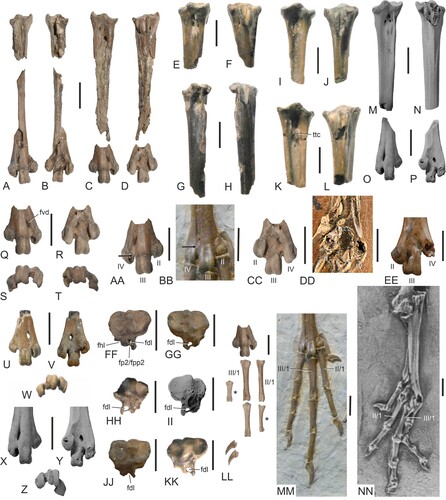
FIGURE 3. Coracoids and scapulae of stem group Galliformes from the Paleogene of Europe, Asia, and North America. A, B, Waltonortyx bumbanipodiides, gen. et sp. nov. from Walton-on-the-Naze, right coracoid (holotype, NMS.Z.2021.40.175) in ventral (A) and dorsal (B) view; the arrow denotes a detail of the extremitas omalis. C, D, undetermined galliform from Walton-on-the-Naze (NMS.Z.2021.40.176), right coracoid in ventral (C) and dorsal (D) view; the arrow denotes a detail of the extremitas omalis. E, Bumbanipodius magnus from the lower Eocene of Mongolia (PIN 3104/195), omal extremity of left coracoid in dorsal view. F, Bumbanortyx transitoria from the lower Eocene of Mongolia (holotype, PIN 3104/265), omal extremity of left coracoid in dorsal view. G, Quercymegapodius brodkorbi (Quercymegapodiidae) from the lower Eocene of France (UM BFI 1849), omal extremity of left coracoid in dorsal view. H, Gallinuloides wyomingensis (Gallinuloididae) from the lower Eocene Green River Formation (WDC CGR−012), left coracoid in dorsal view. I, Paraortygoides messelensis (Gallinuloididae) from the latest early or earliest middle Eocene of Messel (holotype, SMF-ME 1303a), left coracoid in dorsal view; the specimen was coated with ammonium chloride. J, P. messelensis (SMF-ME 11112a), right coracoid in ventral view; the specimen was coated with ammonium chloride. K, cf. Argillipes aurorum from the lower Eocene of Egem in Belgium (IRSNB Av 167), right coracoid in dorsal view; the specimen was coated with ammonium chloride. L, Paraortyx brancoi (Paraortygidae) from the lower Oligocene of Belgium (IRSNB Av 116a), left coracoid in dorsal view; the specimen was coated with ammonium chloride. M, undetermined galliform from Walton-on-the-Naze (NMS.Z.2021.40.176), right scapula in lateral view. N, P. messelensis (holotype, SMF-ME 1303a), cranial extremity of left scapula in lateral view; the specimen was coated with ammonium chloride. Abbreviations: acr, acromion; agm, angulus medialis; cas, crista articularis sternalis; csc, cotyla scapularis; fah, facies articularis humeralis; inc, incisura nervi supracoracoidei; mpr, medial projection; pac, processus acrocoracoideus; pla, processus lateralis; ppc, processus procoracoideus; str, muscle striae; tbc, tuberculum coracoideum. The scale bars equal 5 mm.
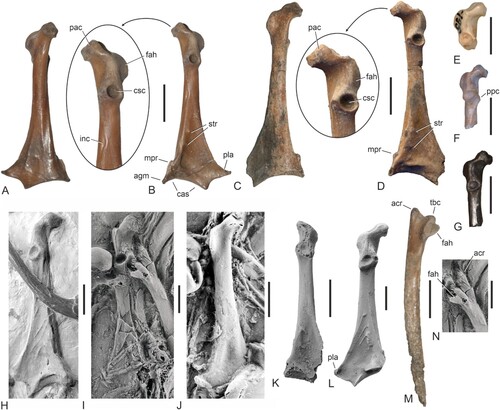
FIGURE 4. Humeri of Eocene stem group Galliformes. A, Waltonortyx bumbanipodiides, gen. et sp. nov. from Walton-on-the-Naze, proximal end of right humerus (holotype, NMS.Z.2021.40.175) in cranial view. B, cf. Argillipes aurorum from the lower Eocene of Egem in Belgium (IRSNB Av 163), proximal end of right humerus in cranial view; the specimen was coated with ammonium chloride. C, Paraortygoides messelensis from the latest early or earliest middle Eocene of Messel (SMF-ME 11112a), proximal end of right humerus is cranial view; the specimen was coated with ammonium chloride. D, Gallinuloides wyomingensis from the lower Eocene Green River Formation (WDC CGR−012), proximal end of left humerus is cranial view. E, W. bumbanipodiides, gen. et sp. nov., proximal end of right humerus in caudal view. F, proximal left humerus from the early Eocene of Mongolia that was referred to Bumbanortyx transitoria by Zelenkov (Citation2021) (PIN 3104/128), caudal view. G, cf. Argillipes aurorum from Egem (IRSNB Av 163), proximal end of right humerus in caudal view. H, P. messelensis (holotype, SMF-ME 1303a), proximal end of left humerus in caudal view; the specimen was coated with ammonium chloride. I, Paraortyx lorteti from the lower Eocene of Belgium (IRSNB Av 115), proximal end of right humerus in caudal view. J, K, undetermined galliform from Walton-on-the-Naze, from the London Clay of Walton-on-the-Naze (NMS.Z.2021.40.176), distal portion of a right humerus in caudal (J) and cranial (K) view. L, Argillipes aurorum from the London Clay of the Isle of Sheppey (NHMUK A 4282), distal portion of left humerus (mirrored to ease comparisons) in cranial view. M, G. wyomingensis (WDC CGR−012), distal end of left humerus in cranial view. N, P. messelensis (SMF-ME 11112a), distal end of right humerus is cranial view; the specimen was coated with ammonium chloride. The arrows in E–I denote the distal terminus of the tuberculum dorsale. In A and B the humeri are shown to scale, in E–I they are brought to the same size. Abbreviations: cdp, crista deltopectoralis; cph, caput humeri; flx, processus flexorius; fpt, second (dorsal) fossa pneumotricipitalis; tbd, tuberculum dorsale; tbv, tuberculum ventrale. The scale bars equal 5 mm.
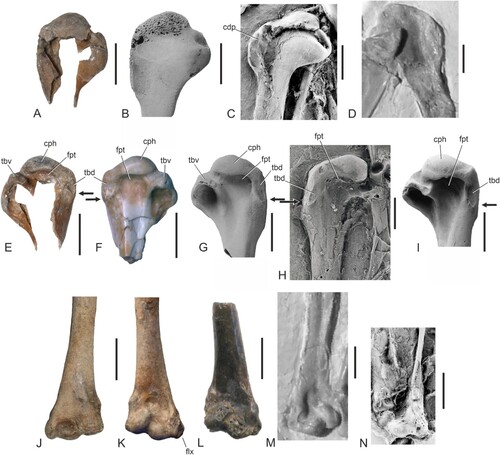
FIGURE 5. Results of the phylogenetic analysis. A, strict consensus tree of 75 most parsimonious trees (L = 55, CI = 0.65, RI = 0.80); bootstrap support is given next to the internodes. B, majority rule consensus tree; the numbers next to the internodes indicate the percentage of replications in which the node was retained.
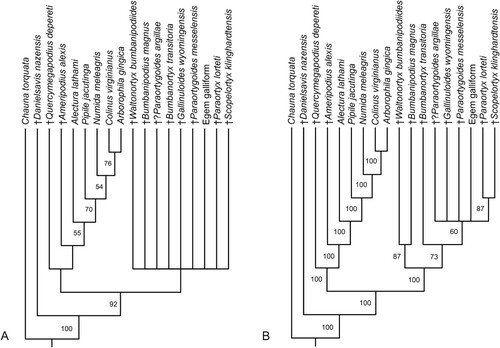
FIGURE 6. Temporal occurrences of early Paleogene stem group galliforms (gray bars) and our preferred tentative hypothesis on their interrelationships.
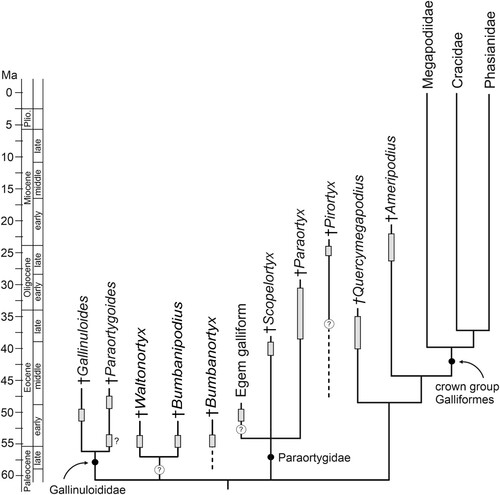
FIGURE 7. Selected elements of the holotype of “Paraortygoides” radagasti (NHMUK A 6217) in comparison to the holotype of ?Paraortygoides argillae, sp. nov. (NMS.Z.2021.40.174) and Rhynchaeites litoralis, a stem group representative of the Threskiornithidae from Walton-on-the-Naze; the dashed frame highlights partial scapulae and coracoids from Walton-on-the-Naze that may belong to “P.” radagasti or a closely related bird but also show a close resemblance to the ibis Rhynchaeites. A, “Paraortygoides” radagasti (holotype), cranial extremity of right scapula in lateral view. B, undetermined galliform from Walton-on-the-Naze (NMS.Z.2021.40.176), cranial extremity of right scapula in lateral view. C, “P.” radagasti (holotype), proximal end of left femur in cranial view. D, ?P. argillae (holotype), proximal end of left femur in cranial view. E, “P.” radagasti (holotype), distal end of right tarsometatarsus in plantar view. F, ?P. argillae (holotype), distal end of left tarsometatarsus (mirrored) in plantar view. G, “P.” radagasti (holotype), proximal end of right tarsometatarsus in proximal view. H, ?P. argillae (holotype), proximal end of left tarsometatarsus in proximal view. I, “P.” radagasti (holotype), cranial extremity of right scapula in lateral view. J, K, NMS.Z.2021.40.177, cranial extremities of both scapulae (J, lateral view) and left coracoid (K, dorsal view), which may belong to “P.” radagasti. L, NMS.Z.2021.40.180, left coracoid (dorsal view), which may belong to “P.” radagasti. M, N, NMS.Z.2021.40.179, partial right coracoid, which may belong to “P.” radagasti, in ventral (M) and dorsal (N) view. O, NMS.Z.2021.40.178, extremitas omalis of right coracoid (dorsal view), which may belong to “P.” radagasti. P, Q, Rhynchaeites litoralis (holotype, NMS.Z.2021.40.28), right coracoid (P, dorsal view) and cranial portion of left scapula (Q, medial view). R, S, fourth cervical vertebra (dorsal view) of “P.” radagasti (R: holotype) and R. litoralis (S: holotype, NMS.Z.2021.40.28). T, U, proximal portion of right carpometacarpus (ventral view) of “P.” radagasti (T: holotype) and R. litoralis (U: NMS.Z.2021.40.29). V, R. litoralis (holotype, NMS.Z.2021.40.28), proximal end of left femur in caudal view. W, R. litoralis (holotype, NMS.Z.2021.40.28), proximal end of left tarsometatarsus (mirrored) in proximal view. In E and F the trochleae are numbered. Abbreviations: acr, acromion; cas, crista articularis sternalis; csc, cotyla scapularis; ctr, crista trochanteris; fah, facies articularis humeralis; fdl, hypotarsal sulcus for tendon of musculus flexor digitorum longus; fhl, hypotarsal sulcus for tendon of musculus flexor hallucis longus; fp2/fpp2, sulcus for the tendons of musculus flexor perforatus digiti 2 and m. perforans et perforatus digiti 2; pex, processus extensorius; ppc, processus procoracoideus; tbc, tuberculum coracoideum. The scale bars equal 5 mm.
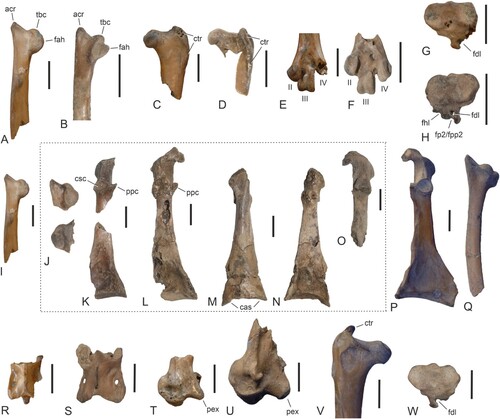
Supplemental Material
Download Zip (56.6 KB)DATA AVAILABILITY STATEMENT
The character descriptions and character matrix are available in the Supplementary Files 1–3. The nexus file used in the phylogenetic analysis was uploaded to the Science Data Bank (www.scidb.cn; doi: 10.57760/sciencedb.16556
).ACKNOWLEDGMENTS
We are indebted to Nikita Zelenkov for providing images of Bumbanortyx, Bumbanipodius, and Quercymegapodius and for permitting their use. We furthermore thank Sven Tränkner for taking some of the other photographs (additional images are by GM). We thank Trevor Worthy and an anonymous reviewer for comments that improved the paper.
